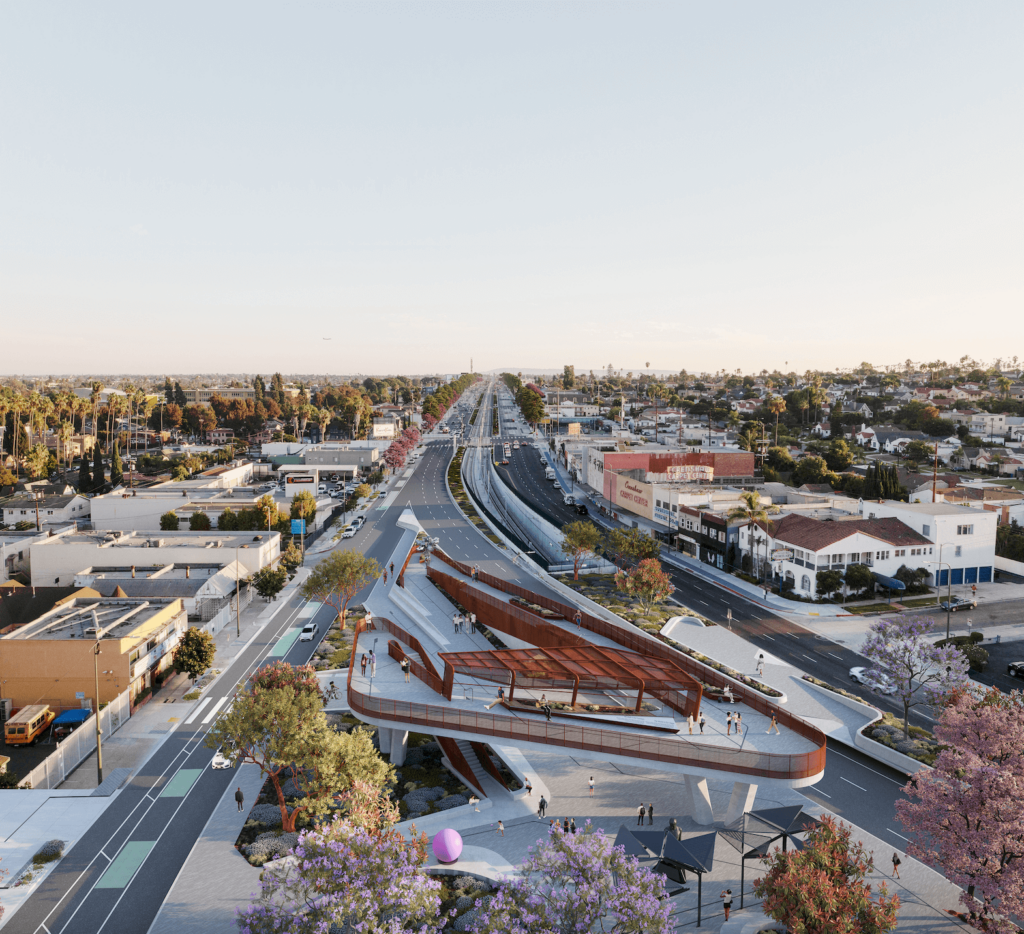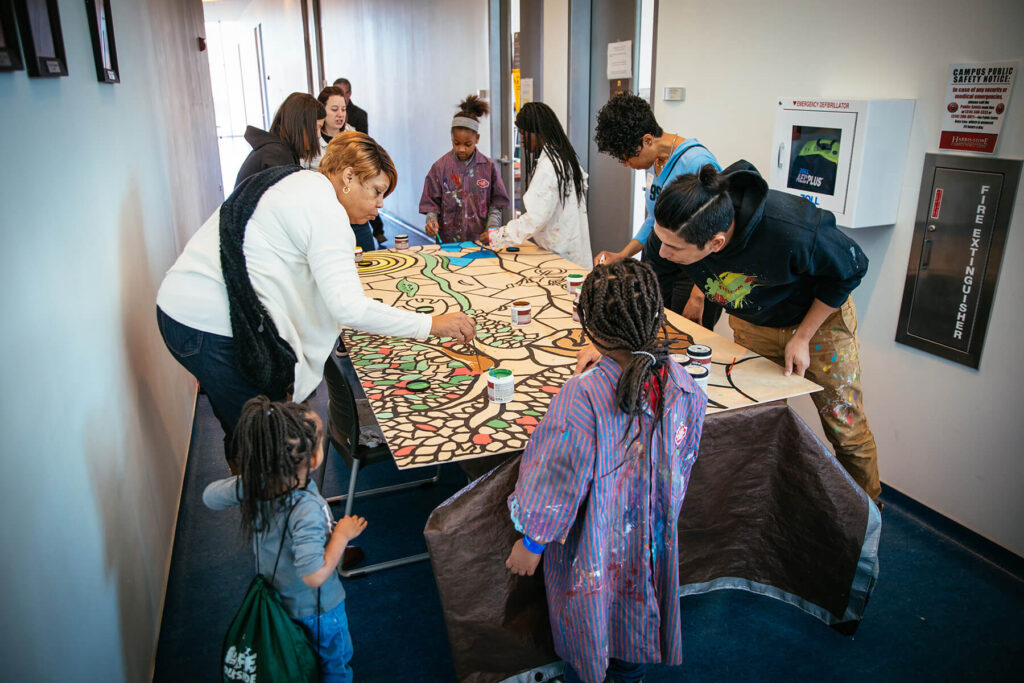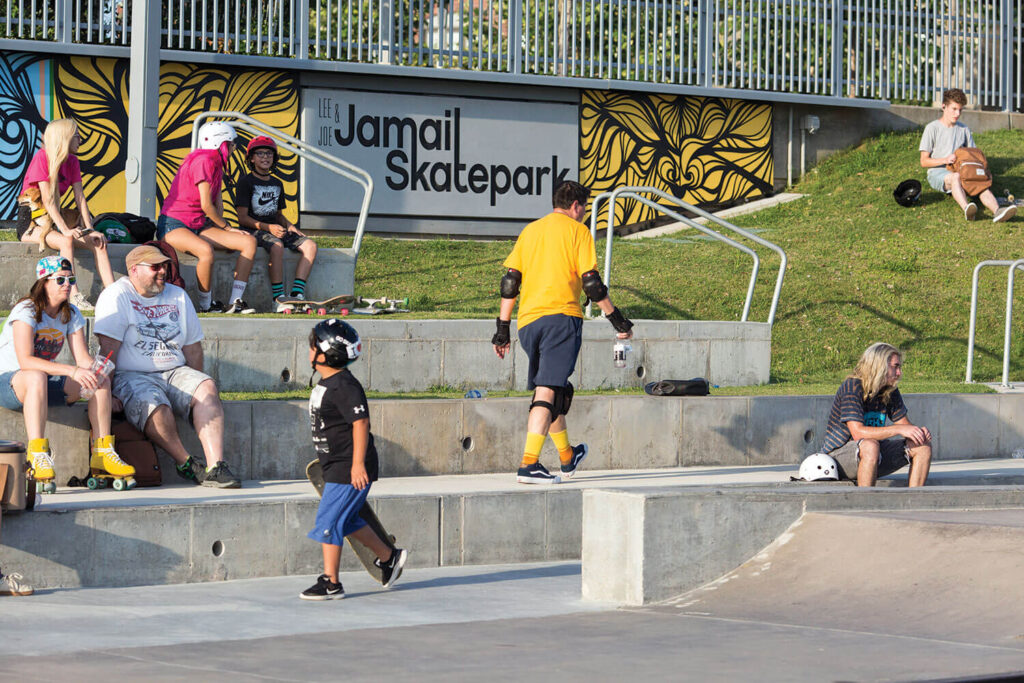Would you like to showcase your own work to embed equity in your infrastructure reuse project?
A Path to Securing New Market Tax Credits

Aerial view of Destination Crenshaw. Credit: Destination Crenshaw
Destination Crenshaw (DC) is an organization with the mandate of becoming the largest Black public art project in the U.S. along Crenshaw Boulevard in South Los Angeles. Destined to be the most dynamic expression of Black American culture in the United States, the project will transform a 1.3 mile stretch of the Boulevard into a thriving commercial corridor through strategic economic and urban investments.
DC wasn’t envisioned as an ordinary park. DC is addressing decades of disinvestment by catalyzing investments in a new kind of public community space. To achieve this ambitious community-centered vision, DC leveraged New Market Tax Credits (NMTC), a federal program designed to increase the flow of private sector capital to businesses, nonprofits, and initiatives in communities that have endured historic disinvestment. NMTC is now yielding over $6 million in funding to support both construction costs and economic investments in the Crenshaw neighborhood, led by DC.
The NMTC program funds projects that prioritize job creation in low income communities including healthcare centers, grocery stores, and manufacturing facilities. Given its intentional focus on economic development, DC applied for NMTC, which offers many benefits versus more traditional federal loan programs. One such benefit for DC is a commitment from NMTC partners, including US Bank, Local Initiatives Support Corporation National, Lendistry, and AFL-CIO/Building America. Through this formal commitment, DC is able to play a strategic role in defining where additional community investments from NMTC partners might be, thus guiding long term investment in Crenshaw. Branch bank managers have already begun reaching out to DC, seeking opportunities to support the organization’s efforts in the neighborhood.
A Community Benefits Agreement was created alongside NMTC partners to establish the desired impacts of the funding. DC was very clear about where the allocation of funds was going and for what purpose. A significant portion will go towards construction of DC’s anchor attraction, Sankofa Park, and the remaining towards working capital and capacity-building for the organization.
A program such as the NMTC requires a sound Theory of Action. Destination Crenshaw set out a strategy to leverage this funding stream. Five core elements centered their approach: a culturally stamped infrastructure project, a transformative union training and employment program, a local small business resiliency program, environmental equity and a Black artist job program. When thinking about how to create impact, some questions DC considered were: What type of staff is going to help achieve our desired impact? How will this help us accomplish our mission? Is this going to help achieve the Community Benefits Agreement?
Additionally, DC created the DC Thrive Drive Program, an initiative sparked by the NMTC and in alignment with their Theory of Action. Funded in part by NMTCs and in alignment with their Theory of Action, DC Thrive’s work to understand the economic impact of the Crenshaw creative economy will drive more intentional funding and opportunities to South LA’s budding entrepreneur ecosystem. DC helped existing business owners identify new commercial ownership opportunities through data collection, community conversations, and pointed research. This value capture process is part of DC’s action plan and directly responds to historic disinvestment.
Amidst the flow of support from NMTC, Destination Crenshaw is also thinking long term: how can nonprofits better leverage their assets, like close community relationships, to fairly benefit from and relate to private sector investors? How can DC continue to create mission-driven public and private investment opportunities that benefit community members and residents? NMTC and the programs activated by DC are helping systematically improve the area while including people in the project’s overall investment.
Project Org
Destination CrenshawRelated Toolkit Section
Center EquityRelated Tool
CRAFT A THEORY OF ACTIONDestination Crenshaw (DC) is an organization with the mandate of becoming the largest Black public art project in the U.S. along Crenshaw Boulevard in South Los Angeles. Destined to be the most dynamic expression of Black American culture in the United States, the project will transform a 1.3 mile stretch of the Boulevard into a thriving commercial corridor through strategic economic and urban investments.
DC wasn’t envisioned as an ordinary park. DC is addressing decades of disinvestment by catalyzing investments in a new kind of public community space. To achieve this ambitious community-centered vision, DC leveraged New Market Tax Credits (NMTC), a federal program designed to increase the flow of private sector capital to businesses, nonprofits, and initiatives in communities that have endured historic disinvestment. NMTC is now yielding over $6 million in funding to support both construction costs and economic investments in the Crenshaw neighborhood, led by DC.
The NMTC program funds projects that prioritize job creation in low income communities including healthcare centers, grocery stores, and manufacturing facilities. Given its intentional focus on economic development, DC applied for NMTC, which offers many benefits versus more traditional federal loan programs. One such benefit for DC is a commitment from NMTC partners, including US Bank, Local Initiatives Support Corporation National, Lendistry, and AFL-CIO/Building America. Through this formal commitment, DC is able to play a strategic role in defining where additional community investments from NMTC partners might be, thus guiding long term investment in Crenshaw. Branch bank managers have already begun reaching out to DC, seeking opportunities to support the organization’s efforts in the neighborhood.
A Community Benefits Agreement was created alongside NMTC partners to establish the desired impacts of the funding. DC was very clear about where the allocation of funds was going and for what purpose. A significant portion will go towards construction of DC’s anchor attraction, Sankofa Park, and the remaining towards working capital and capacity-building for the organization.
A program such as the NMTC requires a sound Theory of Action. Destination Crenshaw set out a strategy to leverage this funding stream. Five core elements centered their approach: a culturally stamped infrastructure project, a transformative union training and employment program, a local small business resiliency program, environmental equity and a Black artist job program. When thinking about how to create impact, some questions DC considered were: What type of staff is going to help achieve our desired impact? How will this help us accomplish our mission? Is this going to help achieve the Community Benefits Agreement?
Additionally, DC created the DC Thrive Drive Program, an initiative sparked by the NMTC and in alignment with their Theory of Action. Funded in part by NMTCs and in alignment with their Theory of Action, DC Thrive’s work to understand the economic impact of the Crenshaw creative economy will drive more intentional funding and opportunities to South LA’s budding entrepreneur ecosystem. DC helped existing business owners identify new commercial ownership opportunities through data collection, community conversations, and pointed research. This value capture process is part of DC’s action plan and directly responds to historic disinvestment.
Amidst the flow of support from NMTC, Destination Crenshaw is also thinking long term: how can nonprofits better leverage their assets, like close community relationships, to fairly benefit from and relate to private sector investors? How can DC continue to create mission-driven public and private investment opportunities that benefit community members and residents? NMTC and the programs activated by DC are helping systematically improve the area while including people in the project’s overall investment.
Share this Case Study


